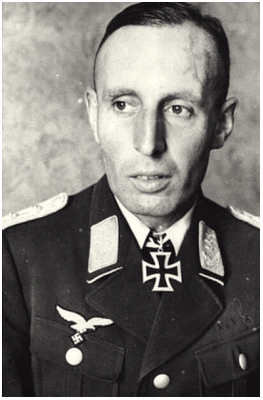
Major Friedrich August Freiherr von der Heydte
The bloody battles that were fought on close range
to gain ground were fruitless. The American artillery started their first barrage of fire on Carentan on June
the 7th. For three days shell's rained on the town. June 10 saw the heaviest shelling when, whitin 24 hours,
6000 shells hit Carentan. A new attack was undertaken the next day, which resulted in more casualties.
But the German para's under command of Von der Heydte kept their positions. In the afternoon the town was
bombarded with fosphorgrenates. Because of the fires that broke out, several civilians came out of their
cellars to flee their town. The American's thought that Carentan was evacuated. With minutes to spare, they
could call of the bombers that were on their way to level Carentan.
That same night the German Falschirmjäger left the town. On 12 June, 1944 Carentan was cleared of the last resistance
and called liberated. The next day the German's returned with units of a Panzer Division.
The attack on Carentan drove the American paratrooper's back to the center of the town.
But the attack was countered when American tanks showed up from Omaha Beach.
To get Carentan and get hold of this important crossroad came at a great price, almost half of the 101st Airborne was lost.
When you approach Carentan from the east on the D974 (you will pass through Saint-Hilaire-Petitville),
Then go over the roundabout, first exit right onto Rue de Pont. After one hundred meters you will reach a
narrow bridge. In June 1944 this bridge, over the river Taute, was blown up by the retreating German
troops. This was at the time the only bridge running to the east (plus 200 meters to the south a railway bridge).
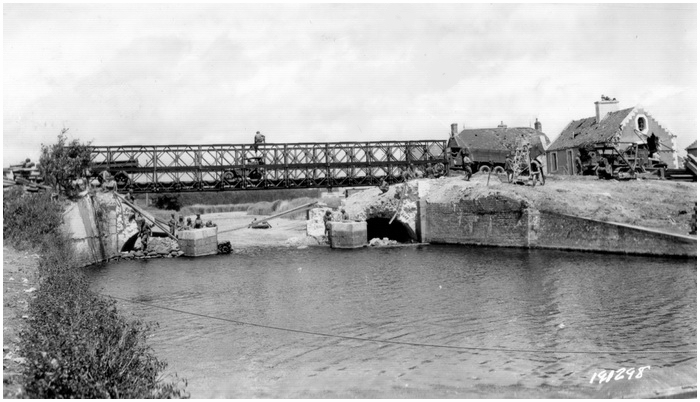 The Bailey Bridge across the river Taute, Then and Now
The Bailey Bridge across the river Taute, Then and Now
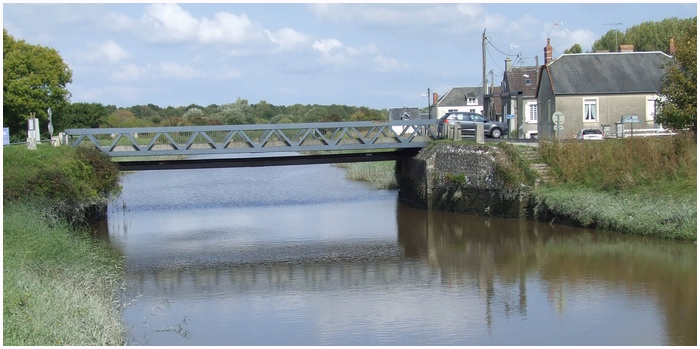
A Bailey bridge over the Taute was constructed so that traffic could go to the east.
To get to the Bailey bridge, vehicles had to enter sharply via
a curve. It was
a life-threatening place, there were daily shelling by Germans towards this bridge.
On June 20, Company B, 300th Engineer Combat Battalion, started building another. During the construction
several victims fell through German artillery. The men were more
hiding then building. On June 27, the commander Major John E. Tucker arrived at the bridge, when
a German barrage of shelling started. Men were looking for a good place to hide again, but Major Tucker walked up the bridge
to encourage his men to continue working. Tucker's gung-ho behavior became fatal for him.
While he threatened with a court martial for those who did not go work, a grenade hit Tucker and took his head clean off.
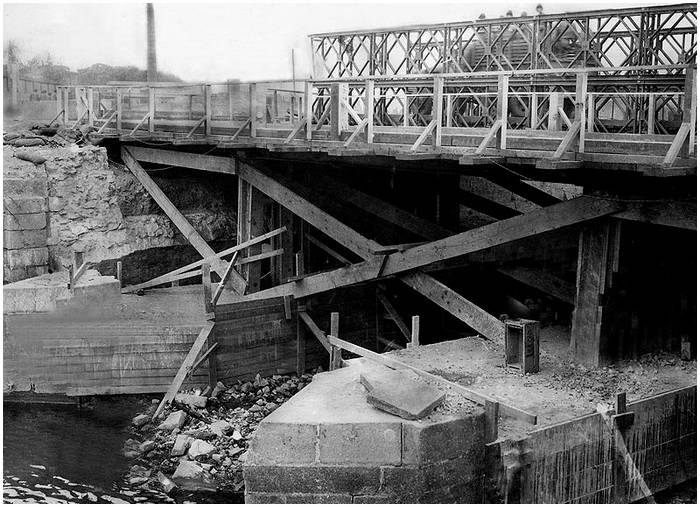 The wooden bridge built by B Comp. 300th Engineer Batt.
The wooden bridge built by B Comp. 300th Engineer Batt.
In addition to the killed Tucker, fifteen more were wounded, four of them seriously enough to be evacuated. On June 28, the
so-called 'wooden yokes bridge' was ready. Next to the bridge a sign was placed with the text: 'Tucker Bridge, in honor of
Major John Tucker killed while supervising construction of this bridge. The bridge would remain in use for over 30 years before a
new permanent bridge was constructed.
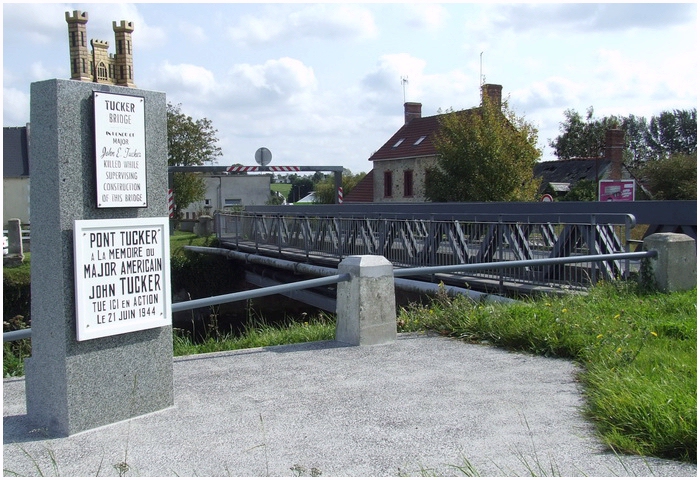 On 5 June 2017 a new monument was unveiled at the Tucker bridge
On 5 June 2017 a new monument was unveiled at the Tucker bridge
Detour to a Bailey bridge
and the story about the 'Filthy 13'
An interesting remnant from the war and still in use in the Carentan area
is a Bailey bridge. This is located over the river Taute at Saint-Hilaire-Petitville.
Also on this page
the action around two bridges where the so-called 'Filthy 13' operated.
To find it all:
CLICK HERE
(after reading, return here)
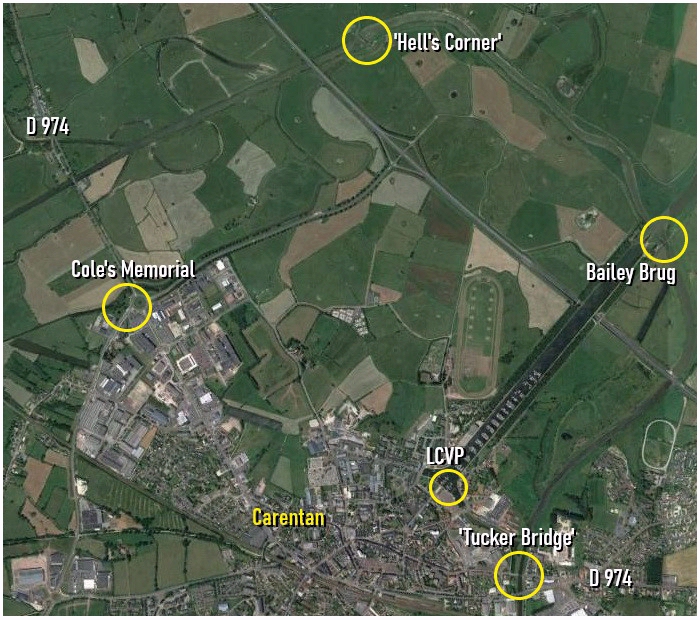
If you have visited the Bailey bridge and the monument of the 'Filthy 13', return to Carentan.
When you approach the harbor, you will see an LCVP in the water right in front of you.
This type of landing craft, the Landing Craft, Vehicle and Personnel was used during the D-Day landings,
especially by the Americans.
This LCVP is an original restored one. Originally this LCVP carried the number n° 586,
but in 1951 received the NATO designation # 9386. In December 1997, the wreck was salvaged at the river Laïta,
20 km northwest of Lorient.
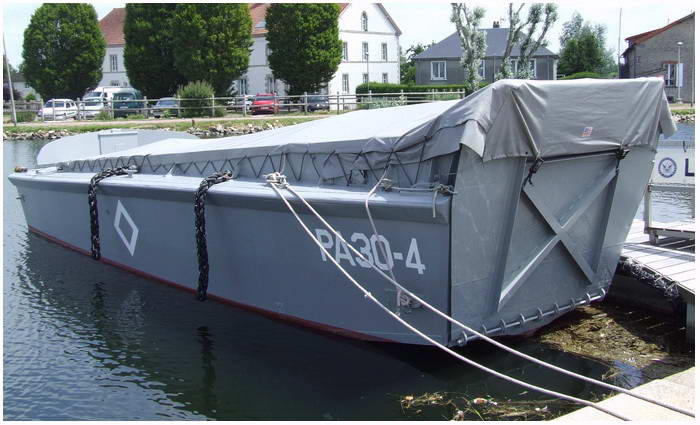
The restored LCVP 'PA30-4' in the harbour of Carentan
In 2004 the restoration of the LCVP was completed and could be admired in all its glory
during the La Barge de la Liberté exhibition at Saint Germain-en-Laye. And now the LCVP, with
the designation PA30-4 can be found in the harbour of Carentan and annually participates in the many D-Day commemoration in Normandy.
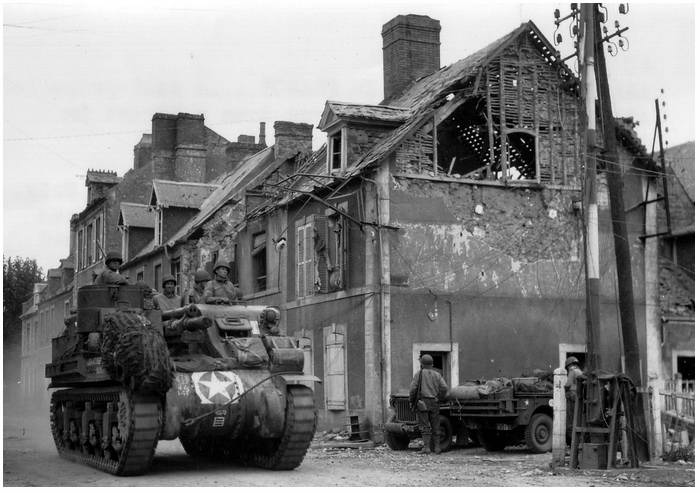 The 2nd Armored Division drives into Carentan, Then and Now
The 2nd Armored Division drives into Carentan, Then and Now
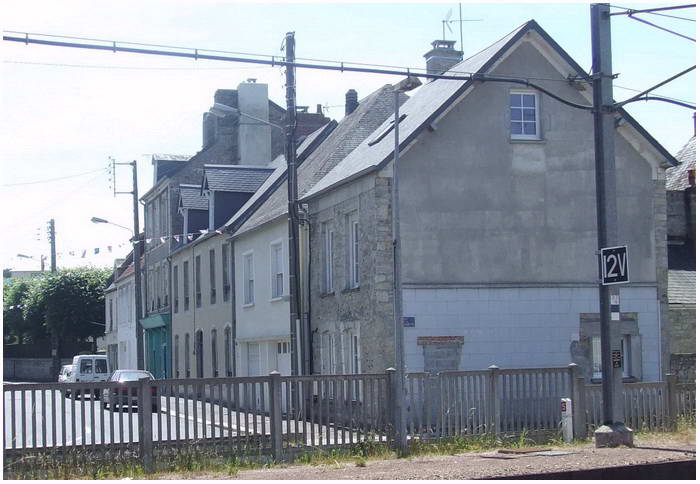
Follow the route north towards St.Côme-du-Mont via the D974.
You leave Carentan via a large roundabout. this is laid out at the point where the famous bayonet attack was fought with
the men under the command of Lt.Col. Robert Cole and successfully took the bridge. In memory
there is a high monument in the northwest corner of the roundabout (see photo at the bottom of this page)
On one of the pages on Margraten you can read more about the heroic story of Lt.Col. Robert Cole
and his men.
After two kilometers on the D974 you will see it right in front of you tht
museum, 'Dead Man's Corner'. Because you are now in the area where the 101st Airborne Division landed,
this museum is
entirely dedicated to the paratrooper.
More on the liberation of Carentan, see the outbreak pages
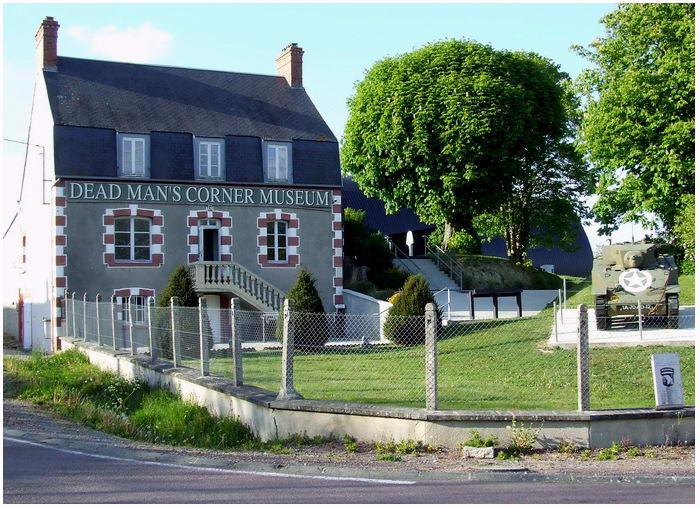 'Dead Man's Corner' with at the rear the 'D-Day Experience'
'Dead Man's Corner'
'Dead Man's Corner' with at the rear the 'D-Day Experience'
'Dead Man's Corner'
Carentan was one of the main goals for the 101st Airborne Division. Because the defense was optimal in Carentan by the Germans, the paratroopers waited for support from tanks. The D 913 was the only road from Exit 2, via St.-Marie-du-Mont towards Carentan which was firmly in the hands of the Americans. At the Y-junction with the D 913 and the D 270 towards
St. Côme-du-Mont stands a house called ‘Dead Man’s Corner’. On how it got his name are different stories. The best known version is the one in which the commander of the tank that was put out of action here was 1e Luitenant Walter T. Anderson from Minnesota of D Company, who ‘hung’ many days out of ‘his’ M5 Stuart. But with new evidence, mostly compiled by Mark A. Bando, there is more to it than this story. The diary of D Company shows that Lt. Anderson was killed in his own tank, number 17, and the M5 Stuart at 'Dead Man's Corner' is Tank number 12.
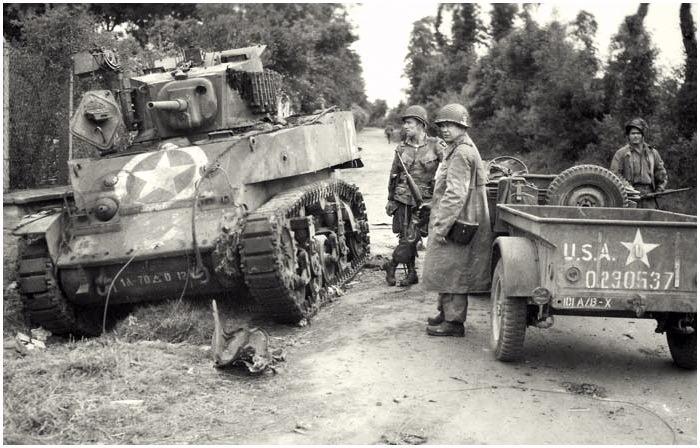 The unfortunate Stuart, Tank 12, near 'Dead Man's Corner'
The unfortunate Stuart, Tank 12, near 'Dead Man's Corner'
On June 7 three Stuarts from D Company, 70th Armored Battalion, were put out of action, Tank 10, 12 and 17. Most written account on this ordeal were lifted from the boek 'Currahee' by Donald R. Burgett, paratrooper van de 101st Airborne Division, ‘“Instead of cutting back the way he had come […] he turned onto the road so he could make better time. That was a mistake. For when he came into view of the 88 near the corner, they drilled an armor-piercing shell straight through the turret. The small tank erupted in a violent explosion and started to burn. The whole crew died instantly. We could smell their flesh cooking in the flames, along with a heavy oily smoke. Seeing the tank crew die that way made me feel bad.” As the pictures shows, this tank has no traces of fire, and also the hole in the ‘sponson’ is not an 8,8cm penetration, it is much smaller, and it looks like it is being hit by a Panzerfaust or a Panzerschreck (according to https://www.wwiidogtags.com it was a Panzerfaust fired by Bruno Hinz took Tank 12 out).
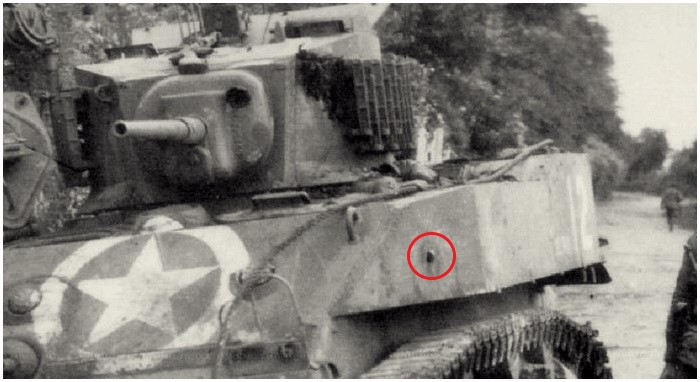 In the red circle the hole from a Panzerfaust?
In the red circle the hole from a Panzerfaust?
During a visit at the spot in 2012 by Burgett he explained that what he had widnessed was more up north, at the old N13, towards St. Côme-du-Mon. Many readers were put on the wrong foot, and put his story with the picture at 'Dead Man's Corner'. The driver of Tank 12, Private Aaron D. Curry, was killed instantly and was kept under the clossed hatch for days. Not 100% sure is the commanders name, but research points to Sergeant Anthony I. Tomashki. Private Jack Hughes, the gunnero r assistance driver, was wounded. Also the fourth man on board, probably Private Ray Bonzo, was wounded with the notion; ‘Non-Battle-Casualty’ (NBC), probably ‘in shock’ (he returned to his unit on 12 July). But hwo the story goes, for the Americans fighting in this part, it was for ever 'Dead Man's Corner' .
The paratrooper-museum is an ongoing project.
In 2015, in a large hall behind the museum, a simulator (the 'D-Day Experience') with an original hull of a C-47
opened where the visitors can experience the 'feeling' that the paratrooper must have felt
during the jump in the dark above Normandy. Since 2016 there is an M5 Stuart tank as an eye-catcher
at the door. The museum is housed in a historic house, and is
very tastefully conceived.
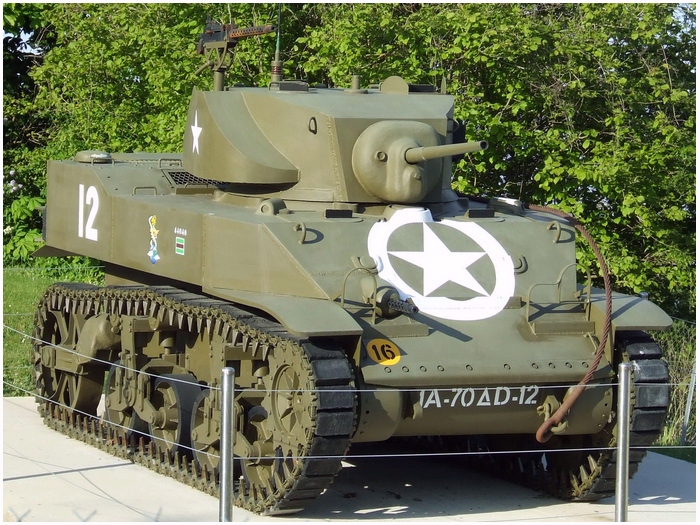 An M5 Stuart tank as a memorial at 'Dead Man's Corner'
An M5 Stuart tank as a memorial at 'Dead Man's Corner'
The Germans used this house first as a headquarters and later as a first aid post.
Downstairs in the museum it is decorated as it would have looked during the first fights in June 1944.
Once you are upstairs, you get an idea that you are in a sort of
C-47 transport plane. The decoration
is of aa high quality. The exhibited items are also very worthwhile. A lot of original
pieces, donated by veterans, are in the showcases (until 2016 there were also objects
from Major Dick Winters, famous for TV-series 'Band of Brothers', but these are
removed by the owner).
In the rear of the museum you can buy authentic souvenirs.
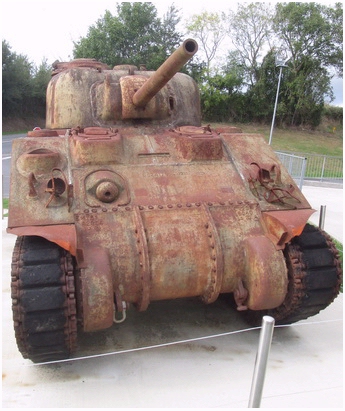
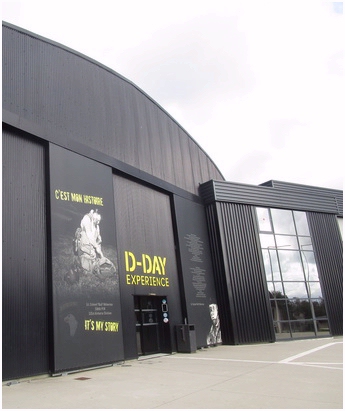 A Sherman tank in front of the giant hall of the 'D-Day Experience'
A Sherman tank in front of the giant hall of the 'D-Day Experience'
On the next page the tour continues towards Utah Beach and the north.
First stop is the church of Saint-Côme-du-Mont and then to Angoville-au-Plain where two American medics
carried out their life-saving work under harsh
conditions.
Click on the picture below
of the memorial commemorating the bayonet attack under the command of Lt.Col. Robert Cole.
RETURN